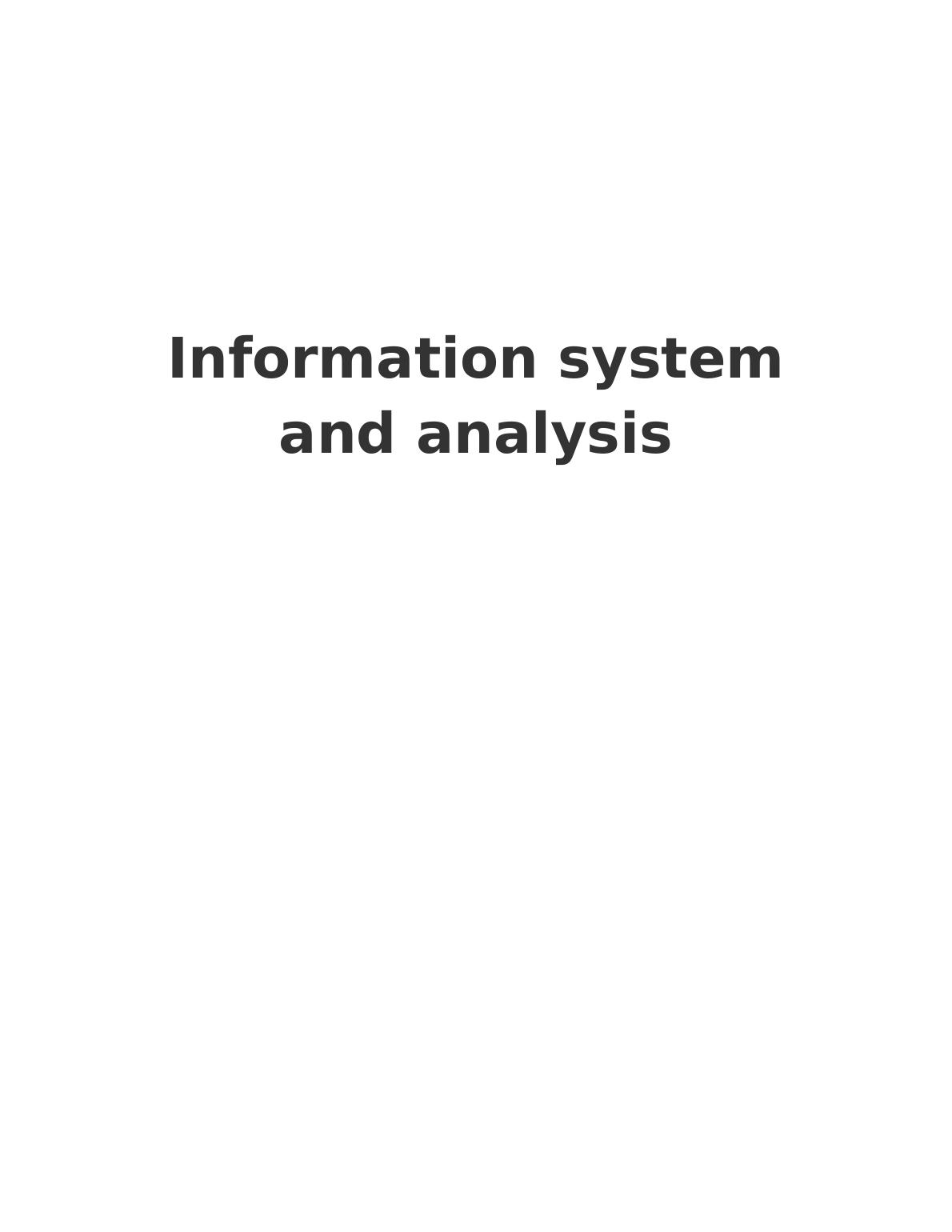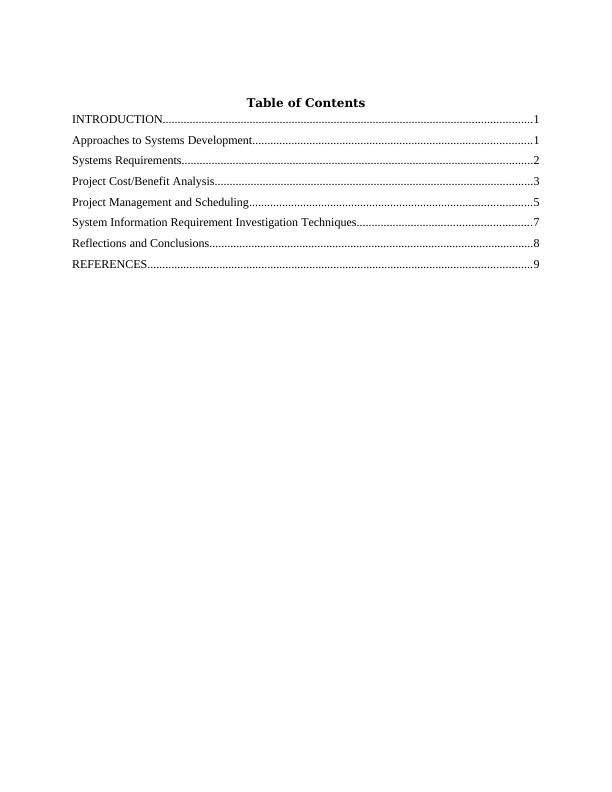Information system and analysis : Assignment
11 Pages2332 Words32 Views
Added on 2021-02-20
Information system and analysis : Assignment
Added on 2021-02-20
ShareRelated Documents
Information system
and analysis
and analysis

Table of Contents
INTRODUCTION...........................................................................................................................1
Approaches to Systems Development.............................................................................................1
Systems Requirements.....................................................................................................................2
Project Cost/Benefit Analysis..........................................................................................................3
Project Management and Scheduling..............................................................................................5
System Information Requirement Investigation Techniques..........................................................7
Reflections and Conclusions............................................................................................................8
REFERENCES................................................................................................................................9
INTRODUCTION...........................................................................................................................1
Approaches to Systems Development.............................................................................................1
Systems Requirements.....................................................................................................................2
Project Cost/Benefit Analysis..........................................................................................................3
Project Management and Scheduling..............................................................................................5
System Information Requirement Investigation Techniques..........................................................7
Reflections and Conclusions............................................................................................................8
REFERENCES................................................................................................................................9

INTRODUCTION
In recent times information system has transformed the way of doing business. It has
enabled in ease of overall business process. IS consists of various features such as storing,
processing, editing, etc. of data and information (Liang and et.al., 2015). IS comprises of ICT
tools which support in business processes.
The aim of report is to find out approaches of system development and what are system
requirements. Also, it will show project cost analysis and scheduling. However, at last
stakeholders involved in project implementation is described.
Objectives of project
To develop and design a new centralised Information system.
Approaches to Systems Development
An IS is designed by using various approaches. It depends on type of system and developer
choice that what approach is been selected (Gordon and et.al., 2015). Also, it is necessary to
select effective approach so that system is designed properly. Each approach is having unique
features and stages. There are different approaches that can be applied by Repair made easy in
developing IS (SDLC approaches, 2016). They are described below :-
Waterfall model – this model was developed by H.D. Benington in 1956. It consists of 5 stages
that are system concept and initiation, requirement analysis and specification, high and low level
design, coding and testing. The model is sequential design where progress flows downward.
V shaped SDLC model- It is similar to waterfall model but there are some added responsibility
as well in system testing and evaluation. There are several phases which is associated with
testing and development stage. It is V shaped model mostly used to design large IS.
Prototype approach- this model is used for developing prototype of system. It focuses on
iterative testing of system until system is built.
Spiral model – this model is integration of both prototype and waterfall model. The main
emphasis is on risk analysis as it allows incremental releases of product through each iteration
around spiral. There are 4 stages in it that are identification, design, construct and risk analysis.
In Repair made easy system design waterfall model can be used. It is because this will
help in structuring design in systematic way. Also, linear life cycle model can be integrated as
well. Therefore, developer will have control over system design. However, each phase will be
completed in effective way.
1
In recent times information system has transformed the way of doing business. It has
enabled in ease of overall business process. IS consists of various features such as storing,
processing, editing, etc. of data and information (Liang and et.al., 2015). IS comprises of ICT
tools which support in business processes.
The aim of report is to find out approaches of system development and what are system
requirements. Also, it will show project cost analysis and scheduling. However, at last
stakeholders involved in project implementation is described.
Objectives of project
To develop and design a new centralised Information system.
Approaches to Systems Development
An IS is designed by using various approaches. It depends on type of system and developer
choice that what approach is been selected (Gordon and et.al., 2015). Also, it is necessary to
select effective approach so that system is designed properly. Each approach is having unique
features and stages. There are different approaches that can be applied by Repair made easy in
developing IS (SDLC approaches, 2016). They are described below :-
Waterfall model – this model was developed by H.D. Benington in 1956. It consists of 5 stages
that are system concept and initiation, requirement analysis and specification, high and low level
design, coding and testing. The model is sequential design where progress flows downward.
V shaped SDLC model- It is similar to waterfall model but there are some added responsibility
as well in system testing and evaluation. There are several phases which is associated with
testing and development stage. It is V shaped model mostly used to design large IS.
Prototype approach- this model is used for developing prototype of system. It focuses on
iterative testing of system until system is built.
Spiral model – this model is integration of both prototype and waterfall model. The main
emphasis is on risk analysis as it allows incremental releases of product through each iteration
around spiral. There are 4 stages in it that are identification, design, construct and risk analysis.
In Repair made easy system design waterfall model can be used. It is because this will
help in structuring design in systematic way. Also, linear life cycle model can be integrated as
well. Therefore, developer will have control over system design. However, each phase will be
completed in effective way.
1

Systems Requirements
In order to design a system it is necessary to determine system requirements. It provides
brief overview about resources required and its cost (Gourlis and Kovacic, 2017). Moreover,
with help of this it is easy to design system and execute it. Basically, there are two common
requirement explained below :-
Functional requirements – these are basic requirements to design a new system. They are
product components which allow user to complete their tasks and specify behaviour between
output and input. The functional requirements are as follows :-
SRS- This is the most important requirement in system. It is a document in which hardware and
software requirements are described. In addition it contains functions, constraints, etc. required
in system. Also, database, system and functional requirements are mentioned in this.
Use cases- It describe interaction between user and system.
User stories- A document which shows what user want software within system to perform
operations.
Software prototypes- Here, it is mentioned about that how system requirements must be
implemented. The prototypes enable in providing solution and showing example that how user
will interact with system (Hughes and et.al., 2016).
Design documents – in this design requirement of system is described. It includes wireframe,
mock-ups, etc. of interface of system.
Non functional requirements- they specify criteria that how system behave and includes
different attributes such as security, performance, reliability, scalability, etc.
Usability – It defines to what extent it is difficult for user to operate system. In this there are
many elements included such as efficiency of use, workload, etc. (de Gusmão and et.al., 2016)
Security – It ensures that system is been protected from unauthorised access. This shows that
how data will be protected, who will have access to it, etc. Moreover, it includes authority and
authenticity of system and data.
Reliability- It gives an insight about how well system will perform in case of failure in particular
time.
2
In order to design a system it is necessary to determine system requirements. It provides
brief overview about resources required and its cost (Gourlis and Kovacic, 2017). Moreover,
with help of this it is easy to design system and execute it. Basically, there are two common
requirement explained below :-
Functional requirements – these are basic requirements to design a new system. They are
product components which allow user to complete their tasks and specify behaviour between
output and input. The functional requirements are as follows :-
SRS- This is the most important requirement in system. It is a document in which hardware and
software requirements are described. In addition it contains functions, constraints, etc. required
in system. Also, database, system and functional requirements are mentioned in this.
Use cases- It describe interaction between user and system.
User stories- A document which shows what user want software within system to perform
operations.
Software prototypes- Here, it is mentioned about that how system requirements must be
implemented. The prototypes enable in providing solution and showing example that how user
will interact with system (Hughes and et.al., 2016).
Design documents – in this design requirement of system is described. It includes wireframe,
mock-ups, etc. of interface of system.
Non functional requirements- they specify criteria that how system behave and includes
different attributes such as security, performance, reliability, scalability, etc.
Usability – It defines to what extent it is difficult for user to operate system. In this there are
many elements included such as efficiency of use, workload, etc. (de Gusmão and et.al., 2016)
Security – It ensures that system is been protected from unauthorised access. This shows that
how data will be protected, who will have access to it, etc. Moreover, it includes authority and
authenticity of system and data.
Reliability- It gives an insight about how well system will perform in case of failure in particular
time.
2

End of preview
Want to access all the pages? Upload your documents or become a member.
Related Documents
Software Development Lifecycle and its Importancelg...
|17
|1624
|60
Software Development Lifecycle Assignmentlg...
|6
|605
|54
System Analysis: Feasibility Study and Lifecycle Modelslg...
|24
|4376
|346
Waterfall Model: Definition and Descriptionlg...
|7
|927
|304
System Analysis and Designlg...
|12
|2033
|160
Relevance of Agile Approaches in IT Service Managementlg...
|10
|3444
|41
